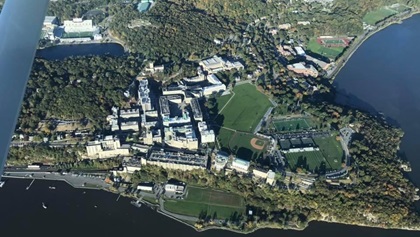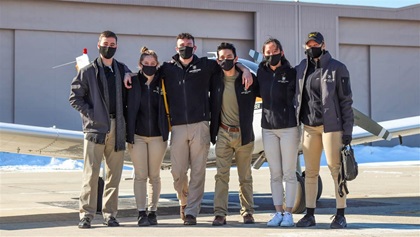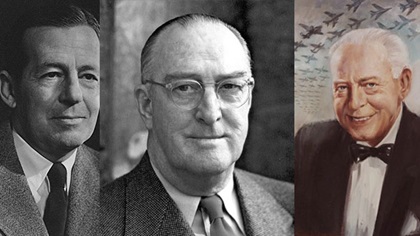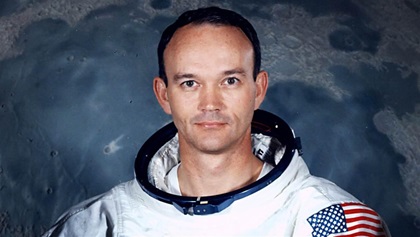First Look: The wings of West Point
Inspiring the next generation of aviators through general aviation
By Chalie Galliand
If you take the opportunity to fly the Hudson River Exclusion Special Flight Rules Area (SFRA), which is something you should do, I encourage you to continue north up the Hudson River about 25 miles. The scenery and historical significance of the area are just as awe-inspiring.

 The river widens as you pass over Governor Mario M. Cuomo Bridge. Continuing north the river narrows again and Bear Mountain State Park and the Bear Mountain Bridge come into view. You make a slight right bank to follow the river as you pass the bridge. Soon, on the west bank jutting out into the river on a prominent point, looms the gothic fortress of the U.S. Military Academy. Better known as West Point—or Hogwarts, to the cadets of the rival service academies—its influence on aviation in the United States is not well known to many but it continues today.
The river widens as you pass over Governor Mario M. Cuomo Bridge. Continuing north the river narrows again and Bear Mountain State Park and the Bear Mountain Bridge come into view. You make a slight right bank to follow the river as you pass the bridge. Soon, on the west bank jutting out into the river on a prominent point, looms the gothic fortress of the U.S. Military Academy. Better known as West Point—or Hogwarts, to the cadets of the rival service academies—its influence on aviation in the United States is not well known to many but it continues today.
 For most people, West Point conjures images of the rockbound highland campus on the Hudson River comprising large gothic buildings, and an expertly manicured field where 4,400 cadets march in a pass in review, known as “The Long Gray Line.” Others think of the Army-Navy rivalry and the football game that occurs every fall before the end of the semester, called “America’s Game.” First associations with West Point are not related to aviation, but the legacy of military aviation began with graduates of the United States Military Academy. Lts. Frederic E. Humphreys, class of 1906; Frank P. Lahm, class of 1901; and Thomas Selfridge, class of 1903, were all students of the Wright brothers and the first military aviators.
For most people, West Point conjures images of the rockbound highland campus on the Hudson River comprising large gothic buildings, and an expertly manicured field where 4,400 cadets march in a pass in review, known as “The Long Gray Line.” Others think of the Army-Navy rivalry and the football game that occurs every fall before the end of the semester, called “America’s Game.” First associations with West Point are not related to aviation, but the legacy of military aviation began with graduates of the United States Military Academy. Lts. Frederic E. Humphreys, class of 1906; Frank P. Lahm, class of 1901; and Thomas Selfridge, class of 1903, were all students of the Wright brothers and the first military aviators.
Today, most officers who graduate from West Point and become military aviators go on to fly helicopters; only a few will go on to fly fixed-wing aircraft. Many of them gained their passion for aviation as cadets through participation in one of West Point’s not-so-well-known general aviation activities. About 30 minutes to the northwest of West Point, “over the mountain,” lies New York Stewart International Airport (SWF). Stewart is a dual-use military and civilian airfield and is home to the 2nd Aviation Detachment, the “Wings of West Point.” In their hangar, across from two UH–72 Lakota helicopters, you will find the Army’s only single-engine piston fixed-wing aircraft. The two Cessna 182s are operated by the Department of Civil and Mechanical Engineering. These Skylanes are used to support the academic flight program, which is part of the aeronautical engineering minor in the mechanical engineering major. The cadets in the program take an in depth look at the engineering aspect of flight, how the aircraft works, and why. Cadets develop hypotheses, make test plans, and take measurements in flight.
West Point’s best-kept aviation secret is the West Point Aviation Club (WPAC). Many of the cadets and faculty involved in the academic program also devote time to WPAC. “The mission of WPAC is to provide leader and military skill development opportunities to cadets interested in Army Aviation as well as achieve consistent success at regional and national collegiate flying team competitions,” its charter says. The West Point Aviation club also operates a well-maintained Piper PA–28-140 Cherokee and rents other Cherokees or an Archer for flight training and competition practice. The club is led by Army and Air Force officers with a range of aviation backgrounds in both military and civil aviation. In addition to providing cadets with leadership opportunities and exposure to the general aviation community, the team competes against other colleges and service academies in the region under the National Intercollegiate Flying Association (NIFA). These competitions reinforce a safety culture, maintain the knowledge required to be a successful pilot, and hone vital flying skills. The team competes in two events per year: a regional NIFA competition in the fall, and an invitational event in the spring with the Naval and Coast Guard academy teams.
West Point may not be known for an aviation focus, but the influence of its graduates on aviation is undeniable. The names and exploits of Henry “Hap” Arnold, Edwin “Buzz” Aldrin, Michael Collins, and Robin Olds are known to most pilots. Most recently, Anne McClain, Army lieutenant colonel, astronaut, Army aviator, and West Point alumna, was selected as a member of NASA’s Artemis team and could be one of the first U.S. astronauts to set foot on the moon since 1972. The West Point Aviation Club continues to influence the next generation of West Point aviators who will continue to contribute to all aspects of aviation in the future.
Chalie Galliand is a major in the U.S. Air Force currently teaching at the U.S. Military Academy. He holds flight instructor certificates for fixed wing and helicopters.
Aviation History: 100 Years Ago
July 22, 1921
Aviation’s early pioneers
 Donald W. Douglas Sr. incorporated The Douglas Co. in July 1921. After parting with David R. Davis, who Douglas had partnered with earlier, contributing just $600, Douglas established one of the most iconic U.S. aircraft manufacturing companies. By 1928, the company was estimated to be worth $25 million. Early employees included Jack Northrop, who would start the Northrop Corp.; Carl Cover, who went on to Bell Aircraft; and James “Dutch” Kindelberger, North American Aviation. Other early manufacturers included William Boeing, who established what became The Boeing Co. in 1916; Edward Stinson, Stinson Aircraft Co. in 1920; William T. Piper, who purchased the assets of Taylor Brothers in 1930 and founded Piper Aircraft; Glenn Curtiss, the Curtiss Aeroplane Co., in 1910; and Walter and Olive Ann Beech, Beech Aircraft Co. in 1932.
Donald W. Douglas Sr. incorporated The Douglas Co. in July 1921. After parting with David R. Davis, who Douglas had partnered with earlier, contributing just $600, Douglas established one of the most iconic U.S. aircraft manufacturing companies. By 1928, the company was estimated to be worth $25 million. Early employees included Jack Northrop, who would start the Northrop Corp.; Carl Cover, who went on to Bell Aircraft; and James “Dutch” Kindelberger, North American Aviation. Other early manufacturers included William Boeing, who established what became The Boeing Co. in 1916; Edward Stinson, Stinson Aircraft Co. in 1920; William T. Piper, who purchased the assets of Taylor Brothers in 1930 and founded Piper Aircraft; Glenn Curtiss, the Curtiss Aeroplane Co., in 1910; and Walter and Olive Ann Beech, Beech Aircraft Co. in 1932.
 Pilot, astronaut, and author Michael Collins died April 28 at age 90. Chosen as one of 14 members of NASA’s third astronaut group in 1963, Collins first went to space as pilot of the 1966 Gemini 10 mission. He also flew the Apollo 11 mission, piloting the command module while crewmembers Neil Armstrong and Buzz Aldrin took the lunar module to the Moon’s surface. Over the course of his life, Collins, who spent a total of 266 hours in space, was awarded the Presidential Medal for Freedom, Robert J. Collier Trophy, Robert H. Goddard Memorial Trophy and Harmon International Trophy.
Pilot, astronaut, and author Michael Collins died April 28 at age 90. Chosen as one of 14 members of NASA’s third astronaut group in 1963, Collins first went to space as pilot of the 1966 Gemini 10 mission. He also flew the Apollo 11 mission, piloting the command module while crewmembers Neil Armstrong and Buzz Aldrin took the lunar module to the Moon’s surface. Over the course of his life, Collins, who spent a total of 266 hours in space, was awarded the Presidential Medal for Freedom, Robert J. Collier Trophy, Robert H. Goddard Memorial Trophy and Harmon International Trophy.

